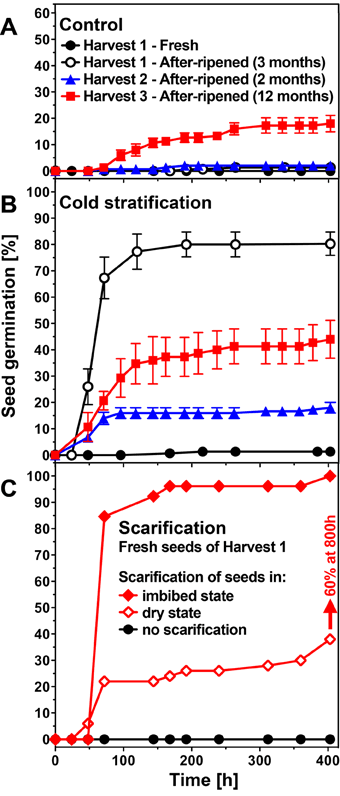Plant Physiology 161: 1903-1917 (2013)
Spatiotemporal seed development analysis provides insight into primary dormancy induction and evolution of the Lepidium DELAY OF GERMINATION1 Genes [W][OA]
School of Biological Sciences, Plant Molecular Science and Centre for Systems and Synthetic Biology, Royal Holloway, University of London, Egham, Surrey TW20 0EX, United Kingdom (KG, AV, GLM);
Web: 'The Seed Biology Place' - www.seedbiology.eu
University of Freiburg, Faculty of Biology, Institute for Biology II, Botany/Plant Physiology, D-79104 Freiburg, Germany (KG, AV, ABM, GLM)
Universität Osnabrück, Fachbereich Biologie, Botanik, D-49069 Osnabrück, Germany (KS, KM)
Received December 24, 2012; Accepted Feburary 19, 2013; Published Feburary 20, 2013.
DOI:10.1104/pp.112.213298
 |
Figure 3. Primary physiological dormancy of Lepidium papillosum seeds and its release by after-ripening, cold-stratification, and scarification. A, Germination kinetics of imbibed L. papillosum seed populations. The primary dormancy of freshly harvested mature ('fresh') seeds was not appreciably released by seed after-ripening. Different harvests and dry storage periods/conditions were compared. Harvest 1 (phytochamber grown) seeds were after-ripened following removal from the mother plant by dry storage at room temperature for 3 months. Harvest 2 (phytochamber grown) seeds were after-ripened on the dried mother plant for 2 months. Harvest 3 (greenhouse grown, 'natural' conditions) seeds were after-ripened on the dried mother plant for 12 months. B, The effect of cold stratification (7 days at 4ºC preincubation) on seed dormancy of fresh and after-ripened seeds. Note that cold-stratification did not release dormancy of fresh seeds, and that differences in the effectiveness of cold-stratification depend on after-ripening storage condition. C, The effect of scarification on imbibed ('coat' removal, i.e. embryo rescue) and dry ('coat' slitting) fresh seeds. L. papillosum seeds are coat-dormant as scarification releases dormancy of fresh seeds; note further that in contrast to this release of dormancy by cold-stratification was only possible for after-ripened, but not for fresh seeds. Mean values ± SE of 3 x 50 seeds. A part of the harvest 1 results is shown for comparison and has been shown earlier by Graeber et al. (2010). |
||
| Article in PDF format (2 MB) Supplementary data file (4.9 MB) |
|
|
|
The Seed Biology Place |
Webdesign Gerhard Leubner 2000 |